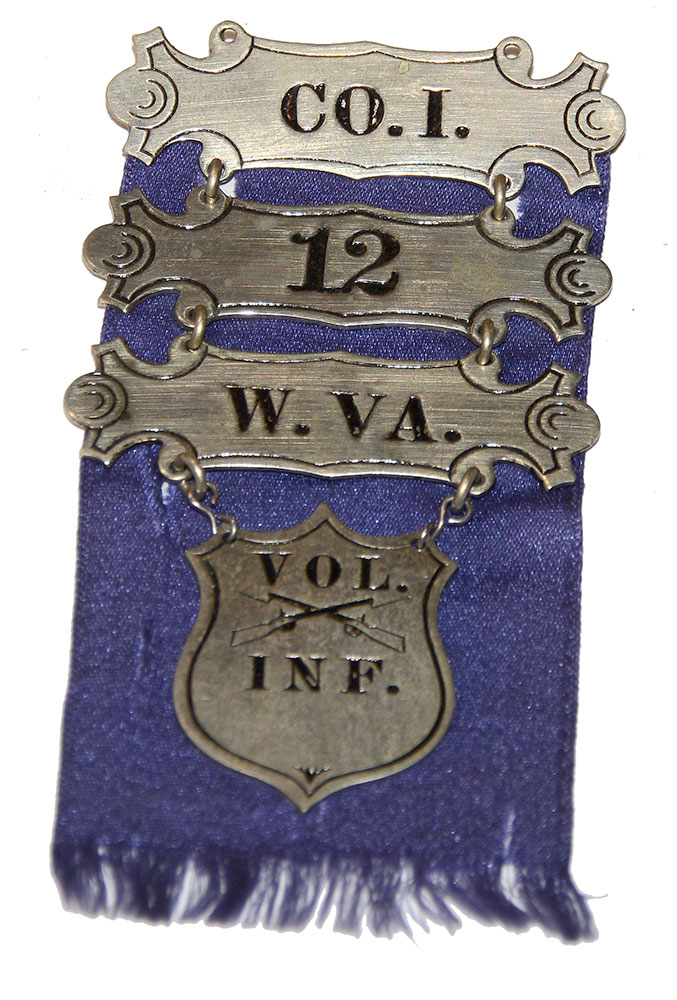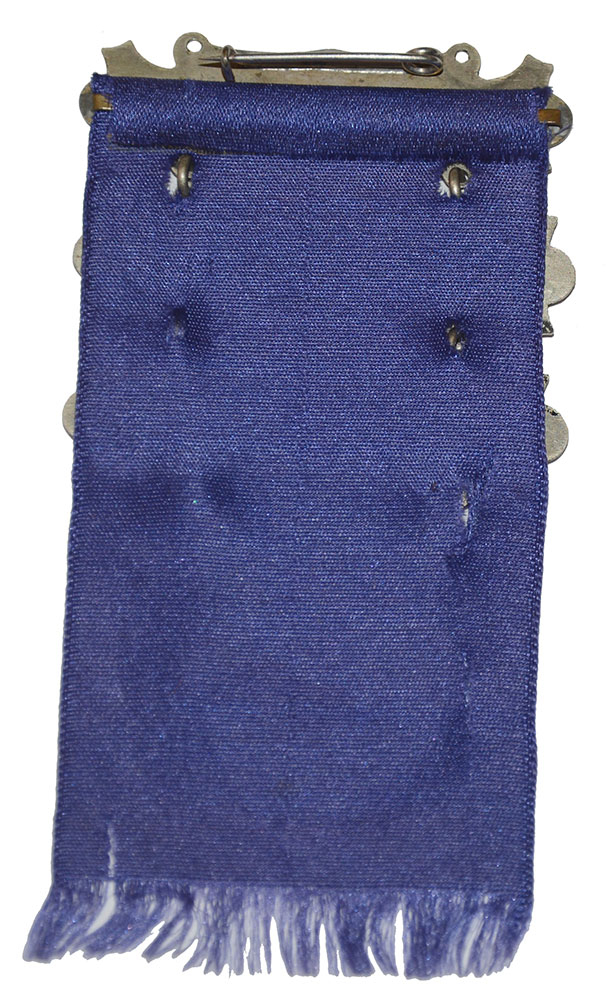site search
online catalog
RARE WV UNION VETERAN LADDER BADGE – 12th WEST VIRGINIA, COMPANY I

Hover to zoom


$350.00 SOLD
Quantity Available: None
Item Code: 2025-964
This ladder badge is of the very rare West Virginia variety, with a navy-blue backing ribbon and bright silver finished pin bar and ladder attachments. The pin bar reads “CO. I” while the subsequent ladders and medallion collectively reads “12 W. VA. VOL. INF.” Black fill colors all text and the reverse portions are unmarked. There are no traces of tarnish across any of the metal surfaces, save for black spotting on the reverse of the medallion. The ribbon is in sound condition, with small holes from the ladder attachment loops (all hidden by the badge excepting the lower left hole). Length from the top of the pin bar to the lower edge of the ribbon is 4”, width is 2”.
West Virginia is unique in that it was born of the Civil War. For the first two years of the conflict, West Virginians served in the US Army as volunteers in units from nearby states such as Ohio, Pennsylvania, and others. However, more than 33,000 “Sons of the Mountains” enlisted in native regiments of a state that, at various points, either did not yet exist or had only existed for a short time.
The Twelfth West Virginia Infantry was organized at Wheeling, Virginia, August, 1862, with John B. Klunk, Colonel; Robert S. Northcott, Lieutenant-Colonel; and Francis P. Pierpoint, Major. Its early service was performed in West Virginia in scouting, guard duty, etc. In January, 1863, we find the regiment at Winchester, in the Middle Department, Eighth Army Corps, General Milroy’s division. In March, it is a part of Col. Geo. Hay’s brigade, still at Winchester. May 11, it is at Clarksburg in General Roberts’ command. June 1, at Grafton; again, at Winchester, June 13 to 15, participating in Milroy’s disastrous defense of that place, when the regiment lost two officers and six enlisted men killed, one officer and 35 wounded. In this engagement Lieut. James R. Durham, of Co. E, while gallantly leading his company in the fight was severely wounded in the right arm and hand.
On June 30, it was at Bloody Run, in Col. L. B. Pierce’s brigade; July 14, at Hagerstown, in Col. A. T. McReynolds’s brigade; August 31, at Martinsburg, in General Kelley’s department; September 1, 1863, Colonel Klunk resigned. December 10, at Charlestown, in command of Major Curtis; December 31, in General Sullivan’s division, Col. Geo. B. Well’s brigade; January 26, 1864, Major Curtis promoted to colonel and in command of the regiment at Harper’s Ferry. At New Creek, February 1, opposed to Early’s and Rosser’s advance upon that place. April 1, at Cumberland, in Colonel Thoburn’s brigade, Sigel’s department; April 15, at Webster and Beverly. May 15, at New Market, in the Shenandoah Valley, in the battle between Sigel and Breckinridge, two killed and fifteen wounded. July 18, at Snicker’s Ferry, in Colonel Thoburn’s brigade. July 24 and 25, at Kernstown in General Crook’s command, Div.-Col. Wm. G. Ely’s brigade, two killed, 19 wounded. September 19, at battle of Opequon, Lieutenant-Colonel Northcott commanding brigade. October 19, at battle of Cedar Creek, under General Sheridan, Colonel Curtis commanding brigade, Lieutenant-Colonel Northcott commanding regiment. In March, 1865, several West Virginia regiments were transferred to the Army of the Potomac, and were incorporated in the 24th Army Corps. The 12th Regiment was assigned to the 3d Brigade of that corps, under command of Col. William B. Curtis, of the 12th, as brigade commander.
While the brigade was in camp at New Market, Va., eight miles below Richmond, it received orders on the 27th of March to proceed at once to the left of our lines on Hatcher’s Rum, to co-operate in a general movement against the enemy. The advance troops struck the enemy’s lines at the angle where their works began to retire, and crossed Hatcher’s Run, silencing two forts, carrying one of them and the line of works between them by assault. The assault on the 2d of April, upon Forts Whitworth and Gregg, and two or three smaller works, were performed under the immediate observation of General Grant, who in his official report makes mention of the troops engaged. The Third Brigade (Colonel Curtis) captured Fort Whitworth and one or two smaller works, taking many prisoners, while the 12th West Virginia Regiment, operating in this brigade, aided in taking Fort Gregg, and distinguished itself for gallantry in the desperate hand-to-hand conflict which the attack on that fort involved. The colors of the 12th West Virginia were the first planted on the works. The gallant color-bearer, Private J. R. Logsdon, of Co. C, was shot dead upon planting the colors there. Several other of the regiment were killed inside the fort, among whom were the gallant Lieut. Joseph Caldwell, of Co. C; Lieut. Josiah M. Curtis, Corporal Andrew Apple, and Private Joseph McCausland, of this regiment; each won from the Government a mark of distinction for their gallantry in this desperate conflict. Maj.-Gen’l John Gibbon, commanding the corps, presented to the regiment a golden eagle for their flagstaff, with the following inscription neatly engraved upon it, viz.: “Presented by Maj.-Gen’l John Gibbon to the 12th W. Va. Volunteer Infantry, for Gallant Conduct in the Assault upon Fort Gregg, April 2, 1865.”
The regiment was mustered out of the service at Burksville, Va., June 16, 1865. The regiment lost during the war, killed and died of wounds, three officers and 56 men; died of disease, 131 men. Total 190.
A piece of history from one of America’s most rebellious States – sure to be a feature of any collection of veterans’ items. [cm] [ph:L]
~~~~~~~~~~~~~~~~~~~~~~~~~~~~~~~~~~~
THIS ITEM, AS WITH ALL OTHER ITEMS AVAILABLE ON OUR WEB SITE,
MAY BE PURCHASED THROUGH OUR LAYAWAY PROGRAM.
CLICK HERE FOR OUR POLICIES AND TERMS.
THANK YOU!
Inquire About RARE WV UNION VETERAN LADDER BADGE – 12th WEST VIRGINIA, COMPANY I
Most Popular
Historical Firearms Stolen From The National Civil War Museum In Harrisburg, Pa »
Theft From Gravesite Of Gen. John Reynolds »
Selection Of Unframed Prints By Don Troiani »
Fine Condition Brass Infantry Bugle Insignia »
featured item
GETTYSBURG MICHIGAN CAVALRY BRIGADE SPENCER RIFLE: SECOND DELIVERY “COPELAND” SPENCER, SERIAL #1811 WITH CONFEDERATE “Q” CLEANED AND REPAIRED STAMP
M1860 Spencer Army Rifles are highly sought after and one falling in the serial number range for issue in Custer’s Michigan Cavalry Brigade before Gettysburg is a holy grail for many. This one has the even rarer attribute of not only falling in the… (172-6073). Learn More »


